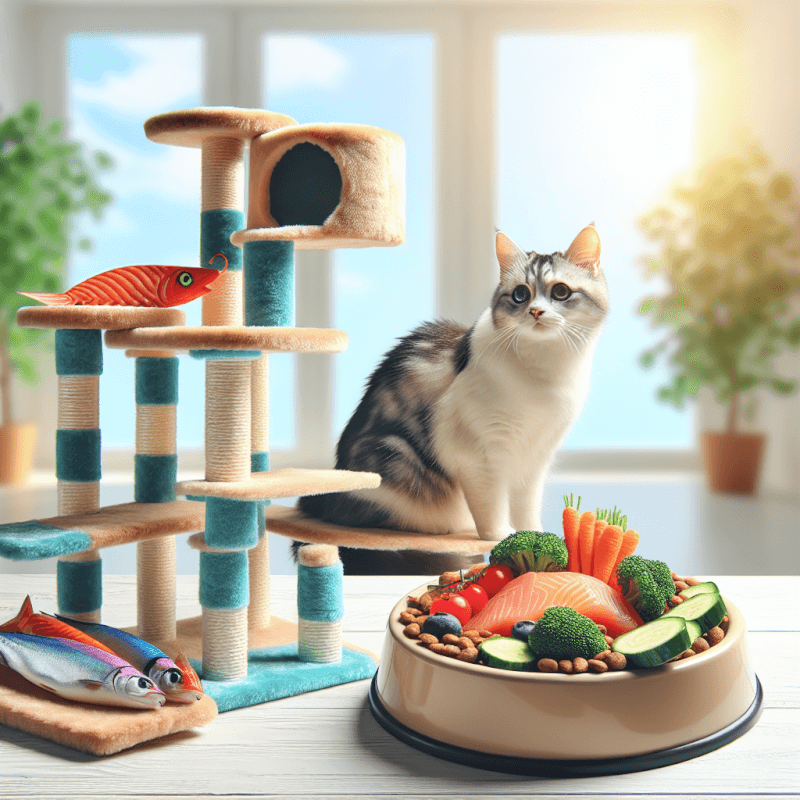Are you worried about your fluffy feline friend packing on a few extra pounds? If so, you’re not alone! Many cat owners have the same concern and want to ensure their feline companions are living their healthiest lives. In this article, we will explore the different ways you can assist your overweight cat in shedding those excess pounds and maintaining a balanced and nutritious lifestyle. Let’s dive into some practical tips and strategies that will have your cat purring with gratitude in no time!

Understanding Obesity in Cats
Obesity in cats is a growing concern among pet owners. Just like humans, cats can also suffer from excess weight, which can have serious health implications. It is important to understand the causes of obesity in cats, the associated health risks, and how to identify if your furry friend is overweight.
Ready for Cat Trivia?
Test your knowledge about cats!

Causes of obesity in cats
Various factors can contribute to obesity in cats. One of the primary causes is overfeeding or providing food with high-calorie content. Cats have a natural instinct to eat whenever food is available, so it’s essential to monitor their food intake. Lack of physical activity and sedentary lifestyles can also contribute to weight gain in cats. This can be due to a lack of mental stimulation or living in environments that discourage play and exercise.
Health risks of obesity in cats
Obesity can have severe consequences on a cat’s health and well-being. Overweight cats are at a higher risk of developing numerous health issues, including diabetes, heart disease, arthritis, and even certain types of cancer. The excess weight places additional stress on their joints and organs, leading to a decreased lifespan and reduced quality of life. By understanding these risks, you can take the necessary steps to prevent and manage obesity in your feline companion.
Identifying if your cat is overweight
Determining whether your cat is overweight is the first step towards helping them achieve a healthier weight. There are several ways to assess if your cat is carrying excess weight. One simple method is to feel their ribcage; you should be able to feel the ribs under a thin layer of fat without them being too prominent. Another indicator is the presence of a sagging abdomen or difficulty in feeling their waistline. If you’re unsure about your cat’s weight, consult your veterinarian, who can provide a professional evaluation and guidance.
Consulting a Veterinarian
When it comes to addressing your cat’s weight issue, consulting a veterinarian is crucial. They possess the necessary expertise to assess your cat’s overall health and devise a tailored weight loss plan.
Importance of veterinary guidance
A veterinarian’s guidance is invaluable when developing a weight loss strategy for your cat. They can evaluate your furry friend’s current health condition, assess any underlying medical issues, and provide personalized recommendations. Since each cat is unique, a veterinarian’s expertise ensures that your cat’s weight loss plan is safe and effective.
Scheduling a vet visit
Before embarking on a weight loss journey, schedule a visit with your veterinarian. During this visit, they will conduct a thorough examination of your cat, which may include measurements, blood work, and discussing their medical history. This information will help determine the best approach to help your cat shed those extra pounds.
Understanding the cat’s overall health
Apart from assessing your cat’s weight, your veterinarian will also evaluate their overall health. This includes examining their teeth, checking for any signs of illness or discomfort, and considering any medical conditions that may require special attention during the weight loss process. By understanding your cat’s complete health picture, your veterinarian can provide tailored advice and address any specific concerns.
Creating a Weight Loss Plan
Developing a weight loss plan for your cat requires setting realistic goals, determining their ideal weight, and designing a proper diet plan.
Setting realistic goals
It is essential to set achievable goals for your cat’s weight loss journey. Rapid weight loss can be detrimental to their health, so it’s best to aim for a gradual reduction in weight. Your veterinarian will determine a realistic target weight based on your cat’s breed, age, and overall health.
Determining the ideal weight for your cat
To determine your cat’s ideal weight, your veterinarian will consider various factors. They will assess your cat’s body condition score, which involves evaluating their overall appearance and feeling their body to check for fat deposits. By determining the optimal weight for your cat, you can work towards achieving and maintaining it.
Designing a proper diet plan
Your veterinarian will help you create a balanced diet plan for your cat’s weight loss journey. This plan will involve feeding them the appropriate amount of food to facilitate healthy weight loss. Special weight loss diets are available that are formulated specifically for cats. These diets often have controlled calorie content and balanced nutrient profiles to support weight loss while ensuring your cat’s nutritional needs are met.
Choosing appropriate cat food
When selecting cat food for a weight loss plan, it’s crucial to opt for high-quality, nutritionally balanced options. Look for products that are specifically formulated for weight management in cats. These foods are designed to be lower in calories while still providing the necessary nutrients. Your veterinarian can recommend suitable brands and help you navigate the vast array of options available.
Understanding portion control
Portion control plays a vital role in managing your cat’s weight. Your veterinarian will guide you on appropriate portion sizes based on your cat’s specific needs. It’s essential to measure food accurately, as overestimating portion sizes can hinder weight loss progress. Using a measuring cup or a kitchen scale can help ensure you’re providing the correct portions.
Managing the Cat’s Diet
In addition to implementing key strategies in the weight loss plan, managing your cat’s diet involves addressing feeding frequency and schedule, avoiding free-feeding, monitoring calorie intake, incorporating low-calorie treats, and preventing begging behavior.
Feeding frequency and schedule
Establishing a regular feeding schedule is essential for weight management. Your veterinarian will advise on the optimal feeding frequency for your cat, taking into consideration their current weight, age, and overall health. Regular, scheduled meals help regulate their metabolism and prevent excessive food intake.
Avoiding free-feeding
Free-feeding, or leaving food out all day, is a common practice among cat owners. However, this can contribute to overeating and weight gain in cats. Instead, it’s recommended to feed your cat measured portions at specific times of the day. This not only allows for portion control but also helps create a routine that aids in weight management.
Monitoring calorie intake
Calorie monitoring is crucial in managing your cat’s weight. Your veterinarian can provide guidance on the appropriate daily caloric intake for your cat’s weight loss goals. Keep track of the calories consumed through their food and treats to ensure they stay within the recommended limit.
Incorporating low-calorie treats
Treats are often a part of our cats’ lives, and it’s important to address their calorie content. Opt for low-calorie treats or consider alternative rewards, such as praise, playtime, or interactive toys. This allows you to provide positive reinforcement without compromising your cat’s weight loss progress.
Preventing begging behavior
Cats are masters at begging for food, and it can be challenging to resist those pleading eyes. However, it’s crucial to stick to the weight loss plan and avoid giving in to their demands. Encourage family members to refrain from sharing food or offering excessive treats to prevent undoing the progress you’ve made.

Encouraging Physical Activity
Physical activity is a crucial component of your cat’s weight loss journey. Regular exercise helps burn calories, improves muscle tone, and promotes overall well-being.
Importance of exercise for weight loss
Exercise is key to helping your cat shed those extra pounds. Not only does it burn calories, but it also helps maintain muscle mass and keeps your cat mentally stimulated. Regular physical activity can also prevent boredom and destructive behavior caused by pent-up energy.
Choosing suitable toys
Selecting the right toys for your cat can make a significant difference in their willingness to engage in physical activity. Consider toys that encourage movement, such as wand toys, laser pointers, or interactive puzzle toys. Experiment with different types of toys to find what interests and motivates your cat the most.
Engaging in interactive play sessions
Engaging in interactive play sessions with your cat is a fantastic way to bond and promote physical activity. Set aside dedicated time each day for play sessions. Use toys that mimic prey, such as feather wands or small toys that can be tossed and chased. These activities stimulate their natural hunting instincts and provide a fun outlet for exercise.
Creating a cat-friendly environment
Creating an environment that encourages physical activity is essential. Set up vertical spaces, such as cat trees or shelves, that allow your cat to climb and perch. Consider providing scratching posts or designated areas for climbing to keep them active. Additionally, ensure that your cat has access to windows or enclosed outdoor spaces to observe the outside world and engage in mental stimulation.
Exploring outdoor options safely
While outdoor exploration can be beneficial for weight loss, it’s important to consider safety measures. Outdoor time should be supervised, and your cat should be on a harness or in a secure enclosed area to prevent accidents or exposure to potential dangers. Consult with your veterinarian on appropriate outdoor activities based on your cat’s health and local environment.
Addressing Emotional Factors
Emotional factors, such as emotional eating, stress, anxiety, boredom, and loneliness, can contribute to weight gain in cats. Recognizing and addressing these factors is essential for successful weight management.
Emotional eating in cats
Cats, like humans, can indulge in emotional eating. They may turn to food for comfort or as a coping mechanism when experiencing stress or anxiety. If you suspect emotional eating in your cat, it’s important to address the underlying emotions and provide alternative methods of support and comfort.
Monitoring stress and anxiety levels
Stress and anxiety can manifest in various ways in cats, which may include excessive grooming, hiding, or changes in appetite. It’s important to create a calm and stress-free environment for your cat by providing hiding places, minimizing loud noises, and ensuring they have their own space where they feel safe. If your cat’s stress levels are high, consult your veterinarian for additional guidance.
Providing mental stimulation
Mental stimulation is crucial to prevent boredom and emotional eating. Interactive toys, puzzle feeders, and treasure hunts can provide mental engagement and distract your cat from food-related behaviors. Regular play sessions that challenge their minds and encourage problem-solving can also be beneficial.
Addressing boredom and loneliness
Cats are social creatures and can experience boredom and loneliness if left alone for extended periods. Provide environmental enrichment, such as rotating toys or introducing new play options, to keep their minds engaged. Consider adopting a companion cat or spending quality time with your cat through play, grooming, or just being present to alleviate feelings of boredom and loneliness.

Considering Weight Loss Supplements
Weight loss supplements can sometimes be a consideration in managing feline obesity. However, it is crucial to consult your veterinarian before introducing any supplements.
Consulting vet before using supplements
Before incorporating weight loss supplements into your cat’s routine, consult your veterinarian. They can assess your cat’s specific needs, evaluate potential risks and benefits, and recommend appropriate supplements, if necessary. Your veterinarian’s guidance ensures that the supplements are safe and complement the overall weight loss plan.
Different types of weight loss supplements
There are various weight loss supplements available for cats. These can include appetite suppressants, metabolism boosters, and supplements that promote fat burning or weight management. Some supplements may require a prescription, while others may be available over-the-counter. Your veterinarian can recommend the most suitable options based on your cat’s individual requirements.
Understanding potential risks and benefits
Weight loss supplements can have potential risks and benefits, depending on the specific product and your cat’s health. It’s essential to have a thorough understanding of the potential side effects and to weigh them against the potential benefits. Your veterinarian will be able to provide you with accurate information to make an informed decision regarding supplements.
Monitoring Progress
Continuous monitoring and tracking of your cat’s progress is crucial for successful weight loss. Regular weighing, documenting changes in behavior, and recognizing positive signs of weight loss are essential components of monitoring your cat’s progress.
Regular weighing and tracking
Weighing your cat regularly allows you to track their progress and make any necessary adjustments to their weight loss plan. Your veterinarian can advise on the appropriate frequency of weigh-ins based on your cat’s individual needs. Keep a record of the weights and monitor the trend over time to ensure steady and consistent weight loss.
Documenting changes in behavior
In addition to tracking weight, documenting changes in your cat’s behavior is important. Look for signs of increased energy levels, improved mobility, and overall increased well-being. Positive changes in behavior can be indicators of successful weight loss.
Recognizing positive signs of weight loss
As your cat progresses on their weight loss journey, there are several positive signs to watch for. These may include the ability to feel their ribs more easily, a visible decrease in body fat, increase in muscle tone, and improved mobility. Celebrate these milestones as they signify progress towards a healthier weight.
Making necessary adjustments
It’s important to stay vigilant and make any necessary adjustments to your cat’s weight loss plan along the way. If weight loss stalls or your cat shows signs of discomfort, consult your veterinarian for reassessment. They may recommend alterations to the diet plan, exercise routine, or explore other approaches to ensure continued success.

Involving the Entire Household
Ensuring the success of your cat’s weight loss journey requires the involvement of everyone in the household. Educating family members about your cat’s needs, establishing a feeding and play routine, and avoiding overfeeding from multiple sources are essential for consistent progress.
Educating family members about the cat’s needs
Educating your family members about your cat’s weight loss journey is vital. Ensure that everyone understands the importance of following the weight loss plan, including measuring food portions, avoiding excessive treats, and sticking to the scheduled feeding and play times. By having everyone on board, you create a supportive environment for your cat’s success.
Establishing a feeding and play routine
Consistency is key when it comes to managing weight loss in cats. Establish a routine for feeding and play sessions that works for everyone in the household. Allocating specific times for meals and play helps regulate calorie intake and ensures that your cat receives the exercise and mental stimulation they need.
Avoiding overfeeding from multiple sources
It’s essential to prevent overfeeding your cat by ensuring that family members understand the importance of portion control. Multiple family members unintentionally feeding extra portions or treats can hinder weight loss progress. Clearly communicate the feeding schedule and portion sizes to avoid overfeeding.
Patience and Persistence
Embarking on a weight loss journey with your cat requires patience and persistence. Understanding the weight loss process, staying committed despite setbacks, celebrating small victories, and maintaining a long-term healthy lifestyle are key to achieving and maintaining a healthier weight for your feline companion.
Understanding the weight loss journey
Weight loss in cats is a gradual process that takes time and consistent effort. It’s important to have realistic expectations and understand that there may be plateaus or slower progress at times. By staying committed and following the weight loss plan, you can help your cat achieve their optimal weight over time.
Staying committed despite setbacks
Weight loss journeys are not always smooth sailing, and setbacks may occur. It’s crucial to stay committed and not get discouraged by minor setbacks. If your cat experiences a temporary weight gain or plateaus, consult your veterinarian for guidance and make any necessary adjustments. Stay positive and focused on the long-term goal of a healthier and happier cat.
Celebrating small victories
As your cat progresses on their weight loss journey, remember to celebrate the small victories. Whether it’s reaching a milestone weight or observing positive changes in behavior, these moments are worth acknowledging. Positive reinforcement, along with your unwavering support, can help keep both you and your cat motivated.
Maintaining a long-term healthy lifestyle
Weight loss is just the beginning; the ultimate goal is to maintain a long-term healthy lifestyle for your cat. Once your cat achieves their target weight, it’s important to continue following a balanced diet, regular exercise routine, and monitoring their overall health. By sustaining these habits, you can ensure that your cat remains healthy and at an optimal weight for the rest of their life.
In conclusion, understanding obesity in cats is crucial for their overall well-being. By consulting a veterinarian, creating a weight loss plan, managing their diet, encouraging physical activity, addressing emotional factors, monitoring progress, involving the entire household, and maintaining patience and persistence, you can help your furry friend achieve a healthier weight and improve their quality of life.



